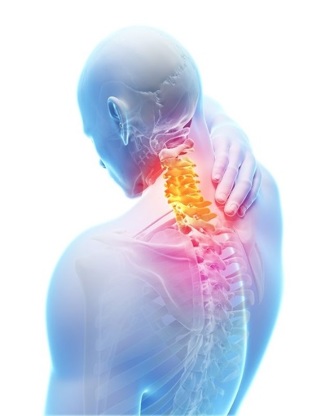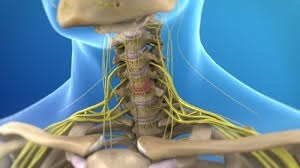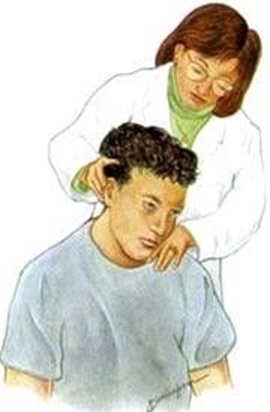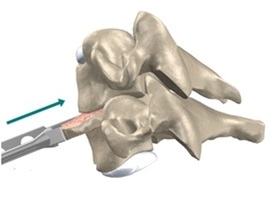A degenerative disease of the disc (osteocondrose) in the region of the cervical department of the spine is the main cause of the manifestations of pain in the neck, and it irradiiruet pain in my hands. The pain from the protests are beginning to appear in the case, when one or more of the intervertebral discs in the cervical region, department of the: vertebral column starts to collapse, for the sake of the world.
The predisposition of certain individuals to the development of degenerative disease of the disc, maybe it has a genetic component. The injury can also speed up, and, at times, to cause the development of degenerative changes in the cervical area, the department of the vertebral column.
In the treatment of degenerative cervical disc disease in the spine gives good results only when he is in the regular nature, and it is a consistent and systematic manner. Osteocondrose of the cervical spine is included in the list of the most common reasons for the symptoms in patients are of working age, who for a long time sitting in front of the computer. Many times, patients do not pay attention to the pain and do not seek medical help , which leads to complications.
Risk factors for degenerative disc disease of cervical spine

While most people will sooner or later develop involutional changes, degenerative conditions in the cervical area, the department of the vertebral column, there are a number of factors that may make it more likely to development of early degenerative disc disease or the appearance of disease symptoms. These risk factors may include the following:
- To achieve more effective results. Some of the twin studies show that genetics plays a large role in the style of life at the beginning of the development of the degenerative disc disease in the cervical department of the spine, and the rapid onset of the symptoms.
- A lot. The weight that is associated with the risk of developing the disease, and degenerative diseases of the disc (degenerative disc disease).
- It is not allowed. It can make it more difficult for the flow of nutrients into the discs and speed up your hydration.
- In addition to this, the injury to the spinal cord, and sometimes it can start or speed-up the process of degeneration in the region of the cervical department of the spine.
The symptoms of
The symptoms of degenerative disc disease, cervical spine, can vary greatly between different people.
When osteocondrose it becomes symptomatic, pain may develop gradually or appear suddenly. The symptoms may vary from discomfort in your neck until you run out of pain radiating to the leg, the numbness and / or weakness of the muscles.
The main symptoms are:
- The pain in the neck. The lower-pain in the middle of the stiffness of the neck is the most common symptom of degenerative disc disease of cervical spine. However, at times, pain may increase dramatically and last for several hours or a few days.
- Neuralgia. This type of pain tends to be sharp or with a sense of shock, radiating to the shoulder, arm, hand and / or fingers. Typically, neuralgia can be felt only on one side of the body.
- The neurological symptoms in the hand-in-hand and / or fingers. May experience sensations of tingling, needles, numbness and / or weakness that may spread to the whole of the upper limb. These types of symptoms may interfere with activities of daily living, such as, for example, to print out, dress it up, or hold on to things.
- The pain has intensified throughout the movement. In general, the pain caused by degenerative disc disease, it is generally enhanced by movement, and is reduced when on a vacation.
- If the pain is from one's own degenerative disc disease of the disc, it will probably go away on its own within a few weeks or months. However, other symptoms of degenerative disc disease of cervical spine more and more, become chronic and require treatment, for example, the facet joints in the neck begin to degenerate, and / or compression of the nerve root.
Less common symptoms
The more the neck becomes, the greater the likelihood of injury to the canal will decrease, and you increase the risk of compression of the spinal cord. If there is compression of the spinal cord , it is going to develop, myelopathy, and will show symptoms such as:
- The difficulty of the movement of the hands and / or feet
- Problems with coordination and / or balance
- The loss of control of bowel and / or bladder
- Weakness and / or numbness anywhere below the neck
- Shooting pain in the limbs, which can raise the incline so the front of
Cervical myelopathy - this is a serious condition that requires immediate medical attention. Usually, this condition occurs in people over the age of 50.
The diagnosis
A diagnosis of degenerative disc disease of cervical spine that can be issued on the basis of data, such as:
- The story of a medical practitioner. In the first place, your doctor should be able to examine in detail the symptoms and medical history.
- With a physical examination. Then, the health care provider will perform a physical examination, by the detection of the neck, and checking the range of motion in your neck. During the test, the patient may be asked to perform certain movements and to report, either increases or decreases the pain in the neck.
- If the pain is severe, or if you are in the presence of the neurological symptoms, such as pain, feeling of "pins and needles" or numbness in the shoulder, arm, or leg, your doctor will most likely prescribe the conduct of medical images .
- Techniques in medical imaging (x-ray, ct scan, mri, and PET). If the doctor considers that, in order to determine the accuracy of the genesis, symptoms, you you you you you must obtain the images of the tissue-units), then most likely, you will be assigned to a magnetic-resonance imaging. Magnetic resonance imaging, x-ray or perhaps a ct scan can check for signs of decay, and it is also necessary to identify the other member states, such as osteoarthritis or stenosis), which can cause the same symptoms.
- After the confirmation of the true diagnosis of the disease, degenerative disc disease of the lumbar disc of the vertebral column, as well as any of the other members of the states, we can understand the Genesis of symptoms, and to determine an effective program of treatment.
The conditions associated with osteochondrosis whiplash

The degeneration of disc is often accompanied by other pathological states, which are or at the same time, or, in some cases, a call to the other. The most common of these are the following states:
- A hernia in a cervical department of a spinal column, occurs in the case in which the degeneration of the disk leads to disruption of the integrity of the fibrous rings, and a barrel for content outside of the ring. But a slipped disc might appear after an injury , which in turn speeds up the degeneration of the disc, and lead to the development of degenerative disc disease of cervical spine .
- Cervical spine osteoarthritis. As the disk degenerates and the space within the spinal column begins to degrade, the facet joints may begin to move in an abnormal way and can cause wear and tear of the cartilage, as well as to promote the formation of bone spurs in the cervical area, the department of the vertebral column.
- Stenosis of the cervical spine. This is a condition that occurs due to bone spurs or herniated discs and a narrowing of the spinal canal (where the spinal cord or foraminal in the hole (where it goes a nervous; bump).
But it is important to understand that, at times, some of the people have from the time of birth, there is a narrowing of the spinal canal, and the development of symptoms, which is not related to osteochondrosis.
Cervical radiculopathy - symptoms of pain, tingling, numbness and / or weakness radiating into the shoulder, the hand and the brush, may occur when one or more of the nerve roots zaselyalsya or angry. If the stenosis occurs in the compression of the spinal cord, a herniated disc or by bone spurs, then you may develop a myelopathy. Symptoms of pain, tingling, numbness and / or weakness can also be experienced at this level and in the region of the neck, and any place below the level of the compression stroke. For example, a person may have a sensation of "pins and needles" or numbness in the legs, problems with balance, or difficulty with control of bowel and bladder.
If you have the symptoms of a myelopathy that is important to you in a timely manner to seek medical attention, as well as the state can move forward, and, without treatment, you may develop paralysis of the limbs, and impairment of function.
Treatment
Usually, when you see the symptoms associated with osteochondrosis whiplash of therapeutic actions taken that are aimed at decrease any symptoms at all. Mainly used for the treatment of degenerative cervical disc disease in the spine is used for the non-surgical methods of treatment.

In the rare cases that they were, when the pain and symptoms do not improve or if they get worse, in spite of several months of treatment, or if there is a risk of injury to the spinal cord, then the problem is resolved, the question of the operation.
The options for conservative treatment
For the treatment of pain in the neck, which is caused by osteochondrosis, a doctor will usually recommend one or more of the following treatment options:
- For the holidays, or a change in life-style. Some of the steps may be the most painful for the neck, for example, the elongation of the neck, in front of you when you work on your computer. The withdrawal or modification of certain types of activities within a few days or a few weeks, usually, to reduce the pain. In addition to this, you must stay in the correct position (at the time outstanding to sit down or bend your neck forward while you're driving, and the t.-d.). The use of healthy food, plenty of hydration, and quitting smoking are also helpful for the health of your hard disk.
- For the treatment of pain, and with the help of medications or injections. The effect can be to give BerezatErnie pain. If the pain is severe, you may be assigned to more than one strong painkiller, such as oral steroids or muscle relaxers, or even in the studies.
In the shot, such as the FAStfull time of the injection, the nerve, or EPIdoralnie on the block. These can include injection of steroids into a specific structure to reduce local inflammation:
- KAUdsocial EPIdoralnie injection
- A shot in the FAStfull-time joint
- Notlaminarnye KAUdsocial EPIdoralnie steroid injection
- Transforaminal EPIdoralnie injection
- The selection of the block the nerve roots
- The blockade of the medial branches of
- Ice and heat can be used in the treatment of degenerative cervical disc disease in the spine.
- The therapy for a year. Most of the non-surgical treatment of degenerative cervical disc disease in the spine, it will include some exercises such as isómerostrachesky and a draw .A selection of the exercises, you should go for a qualified person ( a doctor, therapy, exercise) , as well as insufficient exercise can lead to a deterioration of health status . In addition to this ,the fiscal year should be chosen by taking into account the individual characteristics of each person . In general, the increased strength and flexibility in the neck region, it can reduce the risk of pain and, to a certain extent, the slowing down degenerative changes in the discs.
- The chiropractic treatment. Neck, can be adjusted manually by a technician who is skilled in the area of health, in order to improve the range of motion, and / or to reduce the pain. Depending on a patient's symptoms, it is necessary to carry out a physical examination, and / or manual manipulation to the neck.
- Physical therapy
- Massage
- ThtA saudi arabia
- Corsetrovanie
The surgical treatment of degenerative cervical disc disease in the spine
The operational methods for the treatment of degenerative disc disease, cervical spine, they are generally considered to be two possibilities:
- You are in the presence of the neurological symptoms, such as constant numbness in the hands and / or weakness, or problems with walking or in control of the bowels. If the neurologic symptoms are caused by osteochondrosis whiplash, and there is a risk of irreversible damage to the optic nerve, and surgery may be recommended to reduce the pressure on the nerve.
- Chronic pain is a serious and not amenable to treatment, for at least six months of non-surgical treatment and the daily use it is difficult. For the best results, surgery is designed for patients with chronic pain, in combination with others, such as the instability of the motor, the segments of the neck, and / or radiculopathy.
The main methods of surgical treatment of degenerative cervical disc disease in the spine are:
- The front neck dIskaktOmiya and fusion (ACDF).
- The replacement of the artificial disc.
In addition to this, there are a number of other surgical procedures for the treatment of degenerative disc disease of cervical spine:

- The decompression endoscopic approach
- Endoscopic foramenstOmiya
- Percutaneous decompression
- VNUtridlimitação elektrotErmolina therapy
- Selective endoscopic dIskaktOmiya
- The stimulation of the spinal cord
- Radiofrequency ablation
- EPIdoralny lysis adhesions
The surgical procedure on the neck, and for decompressing the nerve roots and / or spinal cord and is, therefore, a reduction of neurological symptoms, such as pain or weakness and have a tendency to the good far results are positive, the forecast is for 80% to 90% .































